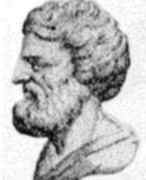Person: Apollonius Of Perga

Apollonius was a Greek mathematician known as 'The Great Geometer'. His works had a very great influence on the development of mathematics and his famous book Conics introduced the terms parabola, ellipse and hyperbola.
Mathematical Profile (Excerpt):
- Apollonius of Perga should not be confused with other Greek scholars called Apollonius, for it was a common name.
- The mathematician Apollonius was born in Perga, Pamphylia which today is known as Murtina, or Murtana and is now in Antalya, Turkey.
- When he was a young man Apollonius went to Alexandria where he studied under the followers of Euclid and later he taught there.
- Apollonius visited Pergamum where a university and library similar to Alexandria had been built.
- The only other pieces of information about Apollonius's life is to be found in the prefaces of various books of Conics.
- We also learn from the preface to this book that Apollonius introduced the geometer Philonides to Eudemus while they were at Ephesus.
- We are in a somewhat better state of knowledge concerning the books which Apollonius wrote.
- First we should note that conic sections to Apollonius are by definition the curves formed when a plane intersects the surface of a cone.
- In book one the relations satisfied by the diameters and tangents of conics are studied while in book two Apollonius investigates how hyperbolas are related to their asymptotes, and he also studies how to draw tangents to given conics.
- In these Apollonius discusses normals to conics and shows how many can be drawn from a point.
- Included in it are a series of propositions which, though worked out by the purest geometrical methods, actually lead immediately to the determination of the evolute of each of the three conics; that is to say, the Cartesian equations of the evolutes can be easily deduced from the results obtained by Apollonius.
- What militates against its being read in its original form is the great extent of the exposition (it contains 387 separate propositions), due partly to the Greek habit of proving particular cases of a general proposition separately from the proposition itself, but more to the cumbersomeness of the enunciations of complicated propositions in general terms (without the help of letters to denote particular points) and to the elaborateness of the Euclidean form, to which Apollonius adheres throughout.
- Pappus gives some indications of the contents of six other works by Apollonius.
- To illustrate how far Apollonius had taken geometric constructions beyond that of Euclid's Elements we consider results which are known to have been contained in Tangencies.
- In Tangencies Apollonius shows how to construct the circle which is tangent to three given circles.
- From other sources there are references to still further books by Apollonius, none of which have survived.
- Hypsicles refers to a work by Apollonius comparing a dodecahedron and an icosahedron inscribed in the same sphere, which like Conics appeared in two editions.
- Marinus, writing a commentary on Euclid's Data, refers to a general work by Apollonius in which the foundations of mathematics such as the meaning of axioms and definitions are discussed.
- Apollonius also wrote a work on the cylindrical helix and another on irrational numbers which is mentioned by Proclus.
- In On the Burning Mirror Apollonius showed that parallel rays of light are not brought to a focus by a spherical mirror (as had been previously thought) and discussed the focal properties of a parabolic mirror.
- Apollonius was also an important founder of Greek mathematical astronomy, which used geometrical models to explain planetary theory.
- Ptolemy in his book Syntaxis says Apollonius introduced systems of eccentric and epicyclic motion to explain the apparent motion of the planets across the sky.
- This is not strictly true since the theory of epicycles certainly predates Apollonius.
- Nevertheless, Apollonius did make substantial contributions particularly using his great geometric skills.
- There were also applications made by Apollonius, using his knowledge of conics, to practical problems.
Born about 262 BC, Perga, Pamphylia, Greek Ionia (now Murtina, Antalya, Turkey). Died about 190 BC, Alexandria, Egypt.
View full biography at MacTutor
Tags relevant for this person:
Ancient Arab, Ancient Greek, Ancient Indian, Applied Maths, Astronomy, Geography, Geometry, Origin Turkey, Physics, Puzzles And Problems, Special Numbers And Numerals
Mentioned in:
Epochs: 1
Thank you to the contributors under CC BY-SA 4.0! 

- Github:
-

- non-Github:
- @J-J-O'Connor
- @E-F-Robertson
References
Adapted from other CC BY-SA 4.0 Sources:
- O’Connor, John J; Robertson, Edmund F: MacTutor History of Mathematics Archive
